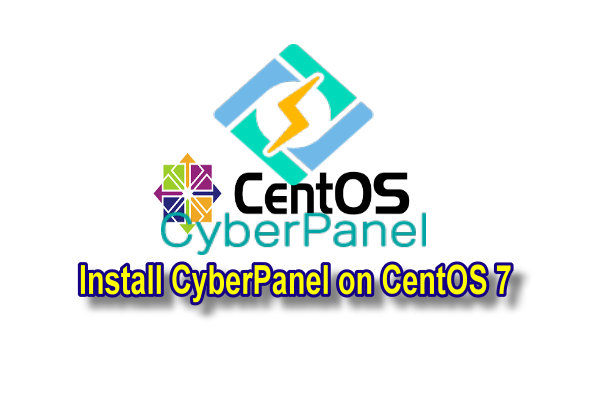Rey.web.id – Guide on how to install CyberPanel, a web-based web hosting control panel with OpenLitespeed and Multi PHP, from PHP 5.3 to version 7.2. This PHP selector will appear when we add a website/domain/sub-domain. So each domain or sub-domain can have a different PHP version.
What is CyberPanel?
Cyberpanel is a hosting control panel that uses the OpenLiteSpeed web server. By using Cyberpanel it will be easier for us to manage hosting. In cyberpanel there is a package that is quite complete for building a website server. These packages include:
- Openlitespeed web server
- FTP
- Database (MariaDB)
- PHP
- SSL
CyberPanel System Requirements
Before starting the installation, make sure your CentOS server meets Cyberpanel specifications.
- CentOS 7 (Recommended version)
- Python 2.7
- 1024 MB RAM or more
- 10 GB disk space
Use the root account to start installing CyberPanel on the server. To avoid conflicts when installing CyberPanel, you should check the status of Selinux, if it is active, you should deactivate it first.
Check Selinux
sestatus
If the result is SELinux status: disabled, just go straight to the Install CyberPanel stage. But if the output is SELinux status: enabled, disable it temporarily with the following command:
setenforce 0
Install CyberPanel
Considering that there are so many software packages to install, make sure the internet connection is stable because the CyberPanel installation process is almost the same as cPanel, takes a long time, around 25 minutes *(Tested with a VPS with specifications of 1GB RAM, 1 CPU).
Command to install CyberPanel
sh <(curl https://cyberpanel.net/install.sh || wget -O - https://cyberpanel.net/install.sh)
The result is like this
RAM check : 75/991MB (7.57%) Recommended minimal 512MB for 1 database instance installation. Recommended minimal 1024MB for 2 databases instances installation. Disk check : 1/49GB (4%) (Minimal 10GB free space) 1. Install CyberPanel with 1 database instance. 2. Install Cyberpanel with 2 databases instances. 3. Exit. Please enter the number[1-3]: 1
This dialog means a choice, do we want to install 1 or 2 MariaDB databases on the server? If there is no special need for your application/project, you should just choose 1, because this option will save memory, so press the number 1 then Enter.
Then there is another question, what version of MariaDB will be installed? I chose MariaDB 10.2, so press number 3 and Enter.
RAM check : 75/991MB (7.57%) You have selected Single Database, Please be mind with RAM requirement. For MariaDB 10.0 Single Database, Recommended minimal 512MB RAM. For MariaDB 10.0 Dual Databases, Recommended minimal 1024MB RAM For MariaDB 10.1 and above: Recommended 1GB RAM for single databse, and 2GB for dual databases. Please note, only MariaDB 10.0 is officialy supported by CyberPanel. Use at your own risk! 1. Install MariaDB 10.0 2. Install MariaDB 10.1 3. Install MariaDB 10.2 4. Install MariaDB 10.3 5. Exit. Please enter the number[1-5]: 3
Wait for the installation process and when it is complete, detailed information about the account and further instructions will appear, like this
CyberPanel Successfully Installed Current RAM usage : 184/991MB (18.57%) Current Disk usage : 3/49GB (9%) Installation time : 0 hrs 25 min 20 sec Visit: https://192.168.10.11:8090 Panel username: admin Panel password: 1234567 Mysql username: root Mysql password: sCu0gTjH9IgK5N Please change your default admin password Version 1.7 has some major changes Must read: http://go.cyberpanel.net/1-7 If you change mysql password, please modify file in /etc/cyberpanel/mysqlPassword with new password as well OpenLiteSpeed WebAdmin Console default: Username: admin Password: 123456 Visit: https://192.168.10.11:7080 By default port 7080 is blocked by firewall It is highly recommended to change default confidential By this command: /usr/local/lsws/admin/misc/admpass.sh
Advanced settings
OK, just follow the instructions
- Access the CyberPanel control panel by opening https://address_IP:8090 then changing the admin user password
- Run the command /usr/local/lsws/admin/misc/admpass.sh in the terminal and setup user and password for the OpenLiteSpeed administrator https://IP_address:7080 (so there are two panels, one for web hosting management (port 8090) and one again for OpenLiteSpeed (port 7080).
- On the admin panel page, on the Security > Firewall menu, add port 7080 then reload the firewall
OK, this is where the tutorial for installing CyberPanel on CentOS 7 is complete. Hopefully it is useful and God willing, it will be posted on this blog soon. Don’t forget to subscribe or follow this blog.















Leave the comments